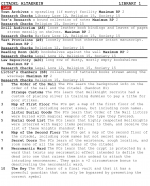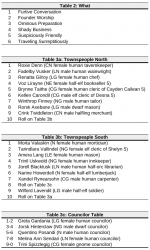As far as advice, the only thing that stands out to me is the thought of running a lot of combats as theatre of the mind. I've found theatre of the mind combat hard to make satisfying in PF2, since combat is so tactical. But I'd be interested to hear if you find a way to get around that problem!
I come to GMing mostly from a horror gaming (nWoD/Chronicles of Darkness and Eclipse Phase) and (post)cyberpunk (Shadowrun 2e/3e and Eclipse Phase) angle and as such I am really good at running theater of the mind. In this situation theater of the mind is good for four reasons
- It doesn’t disrupt the flow of the narrative as much as using maps and minis is and is generally faster (this is obviously extremely important for horror gaming but it is also good here because I may be running a split party). 2e really aids me here because of the integration of exploration and encounter modes: often I find that I can roll forward one or two characters initiatives so only a couple people have to roll at the start of the combat and it is generally easy to logically place PCs based on their described actions (though my players don’t use the specific encounter mode action - they just describe what they are doing and if necessary I choose what specific action they are taking).
- It helps me maintain the atmosphere by keeping everything in the players mind and not abstracting it out into a map on the table. There is a reason that most horror games don’t do mini combat.
- I play in a game store so I need to be ready for new players (not so much since corona though
 ) and theater of the mind is much less intimidating to them (imho) since it is just an extension of what we were doing before (I set up the situation, they give their actions, I maybe ask for a dice roll, I narrate the results, repeat) and we don’t break out of the flow of the game.
) and theater of the mind is much less intimidating to them (imho) since it is just an extension of what we were doing before (I set up the situation, they give their actions, I maybe ask for a dice roll, I narrate the results, repeat) and we don’t break out of the flow of the game.
- It makes it easier for less skilled players (of which I usually have a few) to gain skill because the experienced players will generally state more of their reasoning in theater of the mind (“I move here,” versus “Is there any way I can move into a flank with the last plant zombie?” to which I reply “Yes you can use a single move to flank with X or two moves to flank with Y).
As to engagement: I find it’s all in the narration and player intention. For narration: You really need to set the scene: first when the encounter begins and then after every turn as you transition to the next player. If you do it right you create a very engaging narrative while simultaneously reminding everyone of their position and what’s going on at the start of their turn (similar to what the Angry GM advocates in his running combat like a dolphin article). The second part of the equation is player intent: I kind of noted it above but once you get your players to state their tactical intent with their actions (either as a statement or a question) you can incorporate almost all the tactical decision making of mini based combat into theater of the mind. Let me give an example:
GM: Wizard, immediately in front of you the fighters are grappling with two plant/zombies that have emerged from the jungle, Fighter 1 is fending off his zombie with his shield, but Fighter 2 has taken a couple hits. Past them is the main plant.
Wizard: I want to use widened burning hands to catch all the zombies and the plant?
GM: From where you are you can hit all of them, but you will hit both fighters. Alternately, you could only hit one zombie and one fighter and the main plant.
Wizard. I’m going to hit Fighter 1 and the main plant.
GM: okay roll damage. Fighter 1 roll a reflex save. (I roll for the plants and Crit fail, regular fail).
Wizard: 12 damage!
Fighter: success and I also have fire resistance from my ancestry.
GM: (to Fighter 1) so five damage, (to everyone but mostly Wizard) the zombie gets the brunt of the attack and the spores around it ignite into a pillar of flames, then the blast rolls on to the main plant, destroying a chunk of it as it too ignites. (to Fighter 1) Fighter 1, the zombie in front of you has been completely incinerated, giving you a path to the plant which is badly burned, but the zombie fighting Fighter 2 is untouched, what do you want to do?
Hopefully, that is clear.
Bonus! A helpful tip to those wanting to get better at running combat: record yourself running combat (both theater of the mind and not) and listen to see how engaging you are, how well you paint a mental picture of the battle with just narration, and if there is anything you need to work on in the future (I got this from Happy Jacks too). I did this and after a couple of sessions of deliberately working on my technique I was able to vastly improve (as a specific example: I found I would stop narrating as soon as the minis came out and lapse into ‘you hit’ ‘you missed’ ‘you kill it’, but upon realizing what I was doing l, I was able to correct myself when I started doing that in future games.).


